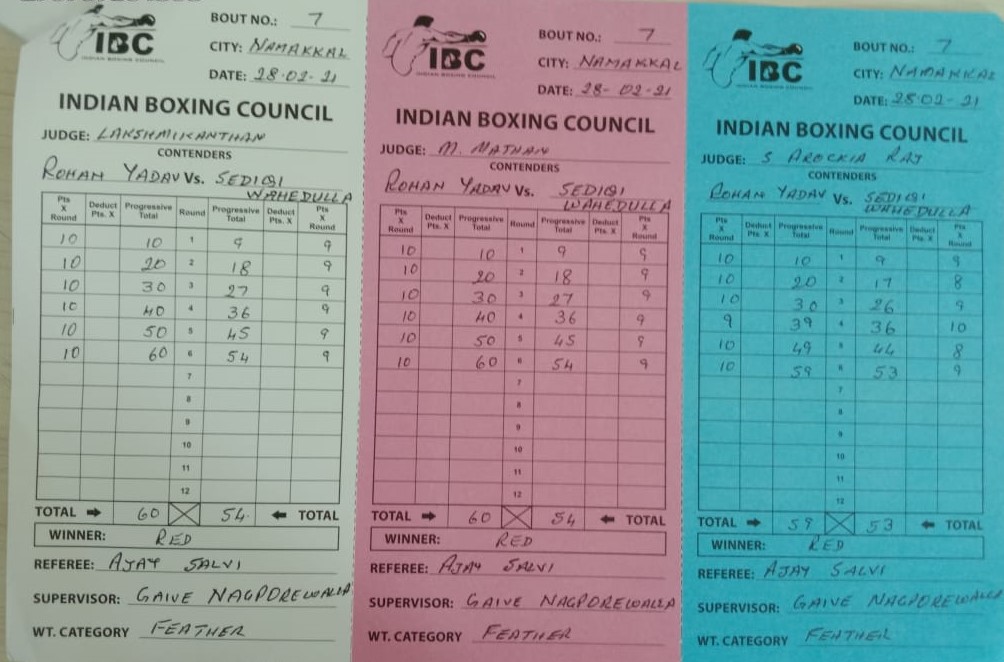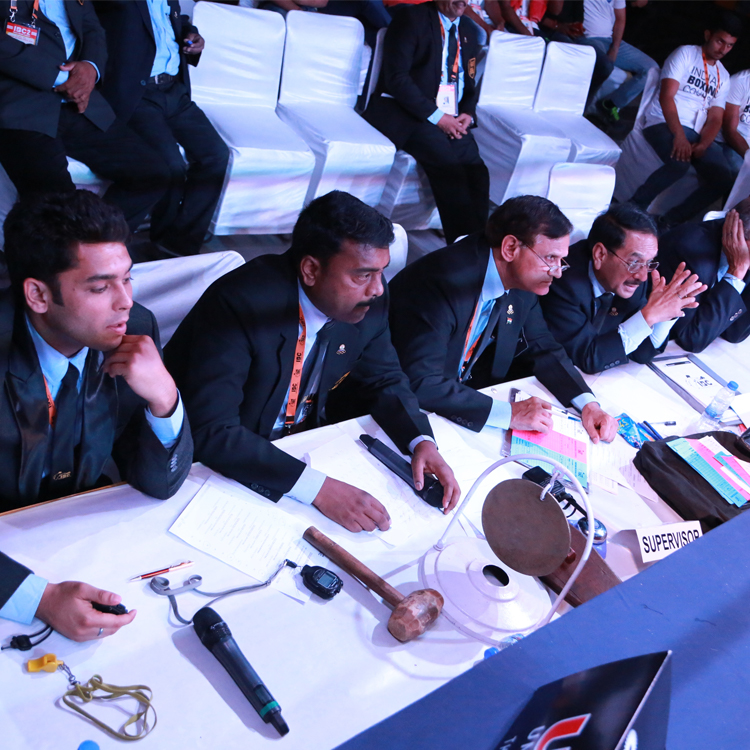Do you want to know the various Boxing rules around decisions and results in Boxing? You’ve come to the right place.
We will answer questions like what is a KO in boxing or what is a Technical Knock Out/ TKO in boxing?
We have put together this post to explain boxing results in our user-friendly guide, listing every kind of fight outcome in Professional Boxing.
UNDERSTANDING THE “10 POINT MUST” SYSTEM IN BOXING

The scoring in Professional Boxing is carried out by three ringside boxing judges who are appointed by the council/ commission.
- The judges follow the “10 point must system ” which means that the boxer who wins a round is awarded 10 points and the loser usually receives 9 points. However, rounds which are viewed as equal are scored as 10-10 also. This happens very rarely.
- The boxing judges give their individual scorecard to the referee at the end of each round. The referee hands these cards to fight supervisor who tallies all the scores from the 3 judges.
- If a bout was agreed for 6 rounds then at the end of 6 rounds, the score tallies of all three judges are added up to determine three “final scores.”
Hence, if one judge feels that Boxer A has won 4 rounds and lost 2, he will award 10 Points to Boxer A for each of those 4 rounds and 9 points for the 2 rounds the boxer lost. Total Score awarded will be (10 X 4) + (9 X 2) = 58.
Conversely, Boxer B must then have won only 2 rounds and lost 4 rounds. Total score awarded to Boxer B will be (10X2)+(9X4) = 56.
- Scores can vary from the usual 10-9 as well. If Boxer A knocks down Boxer B, then the round is scored as 10-8 to Boxer A. If there is a second knockdown, it is scored as 10-7.
- Some National Boxing commissions employ a 3 knockdown rule. A boxer will be declared to have been “Knocked out” if he receives 3 Knockdowns one round. However, the four major global commissions – WBC, WBA, and WBO – do not apply this rule.
- A boxer can also be deducted a point or two points in each round by the referee for persistent rule-breaking. There will usually be a warning first.

UNANIMOUS DECISION VS SPLIT DECISION – WHAT DOES IT MEAN?
It’s true that boxing results can become confusing at times, mainly due to various factors that determine a bout’s outcome.
- UNANIMOUS DECISION – A unanimous decision occurs when all three Boxing Judges agree on a winner.
Example score at the end of 6 rounds of a fight:
- J1: 60-56, A is the Winner
- J2: 60-56, A is the Winner
- J3: 60-56, A is the Winner
Explanation of the above example –
- Judge 1 declares Boxer A as the winner. Judge 1 felt that Boxer A won all 6 rounds and has given 10 points to A at the end of each round and 9 points to B at the end of each round.
- Judge 2 declares Boxer A as the winner with the similar principle applied as Judge 1
- Judge 3 declares Boxer A as the winner with the similar principle applied as Judge 1
- MAJORITY DECISION – A majority decision occurs when two of the three boxing judges score one Boxer as the winner, while the third judge scores neither boxer a winner (a draw).
Example Score at the end of 4 rounds : 40-36, 40-36, 36-36.
- Judge 1 – Boxer A
- Judge 2 – Boxer A
- Judge 3 – Draw
- MAJORITY DRAW – A majority draw occurs when two Judges vote for a draw, while the third Judge chooses a winner. The bout is recorded as a draw on both Boxers’ records.
Example: 36-36, 36-36, 38-36.
- Judge 1 – Draw
- Judge 2 – Draw
- Judge 3 – Boxer A
- SPLIT DECISION– A split decision occurs when two of the three Judges score one boxer as the winner, while the third Judge scores the other Boxer as the winner.
Example in a 10 Round Bout : 116-114, 116-114, 113-115.
- Judge 1 – Boxer A
- Judge 2 – Boxer A
- Judge 3 – Boxer B
- SPLIT DRAW– A split draw occurs when one Judge in favour of one Boxer, the other Judge in favour of the opposite Boxer and the third Judge scores the bout even. The bout is recorded as a draw on both Boxers’ records.
Example in a 10 Round Bout: 116-114, 113-115, 114-114.
- Judge 1 – Boxer A
- Judge 2 – Boxer B
- Judge 3 – Draw
- DRAW – A draw is when both Boxers tie or earn equal number of points from all the Judges scoring the bout.
Example in a 10 Round Bout: 114-114, 114-114, 114-114.
- Judge 1 – Draw
- Judge 2 – Draw
- Judge 3 – Draw
KO / TKO IN BOXING
KNOCK OUT (KO) – A Boxer loses by a “Knockout or “KO” when he receives a knockdown and is unable to continue boxing after the count of ten (10) by the referee. The Referee immediately makes it known by waving both arms.
A KO can also happen when one of the boxers claims a low blow and throws himself on the floor or otherwise indicates his unwillingness to continue the fight. In this scenario if the Referee does not agree that there was a low-blow, the knockdown Judge and the Referee shall immediately begin the count and if the Boxer does not resume the fight before the count of ten (10), he/she shall be declared the loser by KO (Knockout).
If a Boxer has received three (3) knockdowns due to severe head blow or series of hard blows on the head in the same round, he shall lose the bout by “Knockout or KO” if previously agreed upon during IBC Supervisor meeting.
TECHNICAL KNOCK OUT (TKO)
The Referee will stop a bout by Technical Knockout when:
- A Boxer is being outclassed
- A Boxer is receiving excessive punishment
- When a Boxer is unable to continue due to an injury or simply does not want to continue
- When the corner seconds stop the bout
- When the Ringside Physician recommends that the bout be stopped ( Referee is the ultimate decision maker)
If a TKO occurs, the Referee will go to the Boxer, remove his mouthpiece and escorts him/her to his/her corner. The Referee should notify the Ringside Physician and request him/her to examine the Boxer. The Referee should then notify the fight supervisor of his decision.
HOW IS KO DIFFERENT FROM TKO IN BOXING
A TKO is often confused with a KO in Boxing. A technical knockout (TKO) occurs due to referee’s discretion and this does not depend on whether a boxer can get up before the completion of 10 count after a knockdown.
In other words, a TKO occurs when the referee, stops the fight owing to concern for the safety of the boxer. The referee will usually signal this decision by crossing his hands.
For example,
- If Boxer A is knocked down and gets back to his feet before the count of 10, but he appears to be seriously hurt. The referee sees that his legs may be shaky, eyes glazed, or is unable to respond to the referee’s instruction to ‘walk towards him’.
- If Boxer A is on the ropes and appears to be hurt and defenceless. He may be returning very little or no punches at Fighter B who is throwing a flurry of punches that the referee feels could seriously injure Fighter A
- If Boxer A is barely able to compete. Even though he appears somewhat mobile and able to punch, he has become heavily fatigued and or despondent due to an accumulation of punishment from Fighter B over the course of the fight. The referee therefore feels Boxer A is unable to properly defend himself and compete.
- If Boxer A is taking serious beating from Boxer B and the referee sees Boxer A’s corner throw the towel in the ring and promptly halts the bout
TD, NO DECISION, DISQUALIFICATIONS
- TECHNICAL DECISION – If a bout is scheduled for more than four rounds and an accidental foul causes an injury severe enough for the Referee to stop the bout after four (4) rounds have occurred the bout will result in a “Technical Decision” awarded to the Boxer who is ahead on the score cards at the time the bout is stopped. Partial or incomplete round will be scored. If no action has taken place between both the Boxer’s, the round should be scored as an even round. If an intentional foul causes an injury and the injury results in the bout being stopped in a later round, the injured Boxer will win by “Technical Decision” if he/ she is ahead on the score cards.
- TECHNICAL DRAW -If an intentional foul causes an injury and the injury results in the bout being stopped in a latter round, the bout will result in a “Technical Draw” if the injured Boxer is behind or equal on the scorecards.
- DISQUALIFICATION (DQ) – If an intentional foul cause an injury and the injury is severe enough to terminate the contest immediately, the Boxer causing the injury shall lose the bout by Disqualification (DQ). The offender will also lose by disqualification when his/her opponent gets cut by an intentional head butt and cannot continue fighting. If the Referee feels that a Boxer has conducted himself in an un-sportsmanship like manner, he/she may stop the contest and disqualify the Boxer. If both Boxers are disqualified, (termed as double disqualification) the result is usually declared as “No Contest” regardless of round.
- NO DECISION -If an accidental foul cause an injury and the injury is severe enough to terminate the contest immediately, the contest will result in “No Decision” if stopped before four (4) complete rounds, in case of a 6 round/ 8 round / 10 round /12 round bout. Similarly if the bout is stopped before two (2) complete rounds in case of a 4 round contest, then also the result will be “No Decision”.
- REFEREE TECHNICAL DECISION – When a bout ends and a Boxer refuses to continue to box after one minute interval or a Boxer’s “Chief Second” refuses to allow the Boxer to continue.






